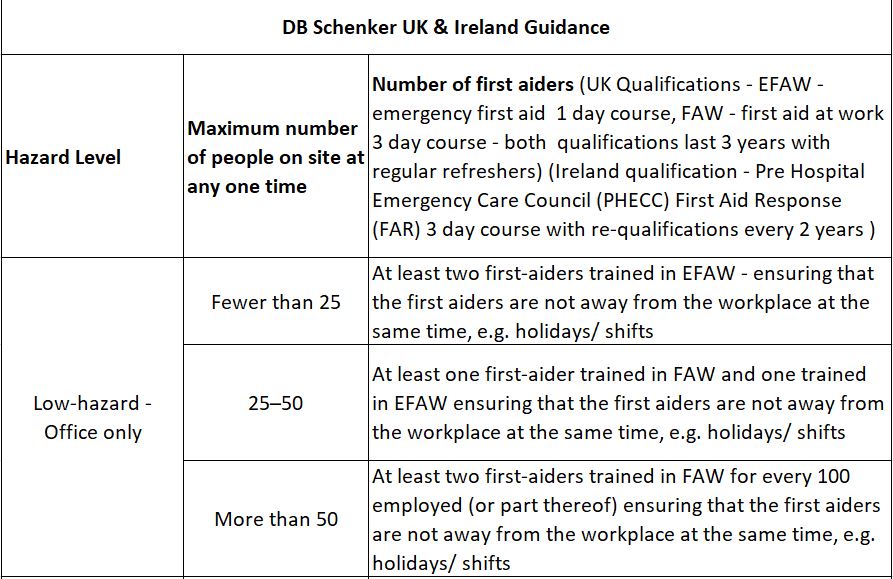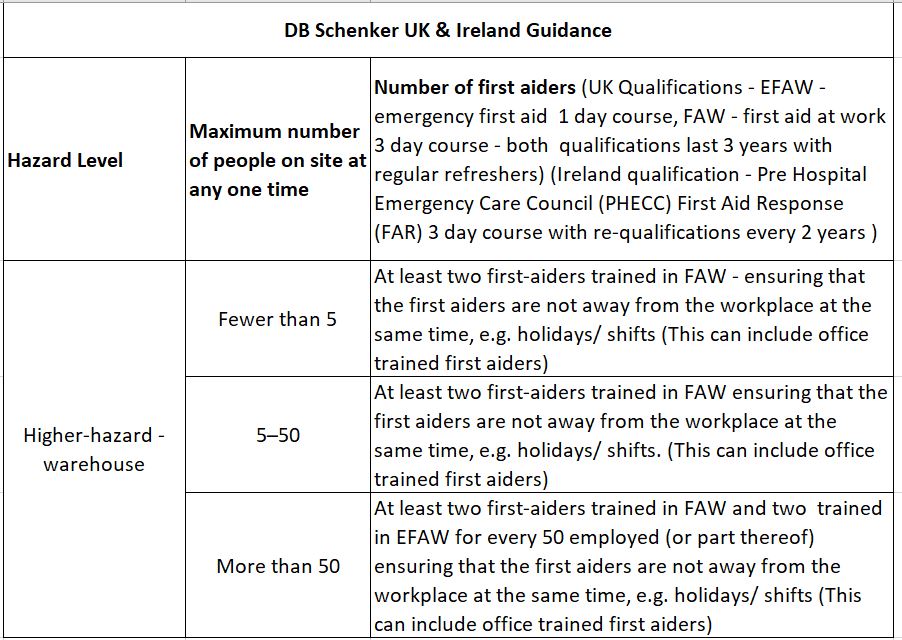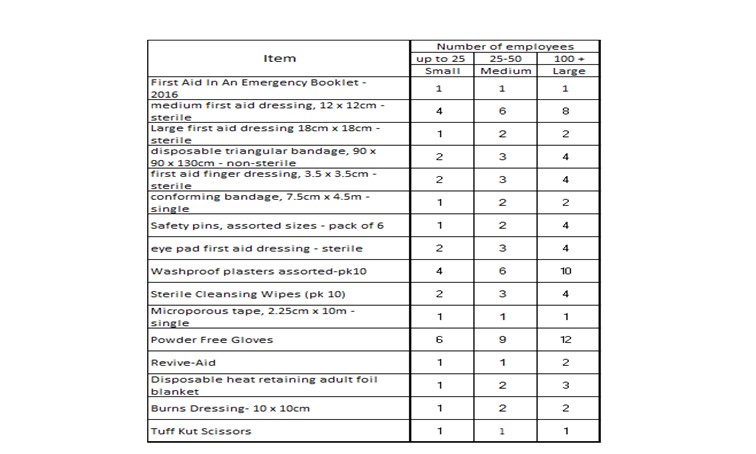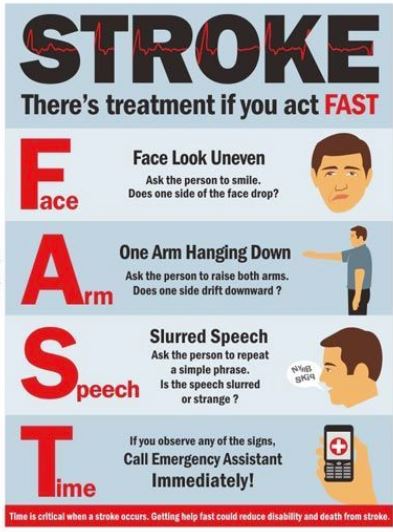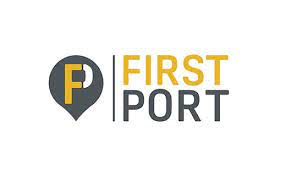Title Page
-
Site conducted
-
This risk assessment has taken into consideration the following legislation: The Health and Safety (First-Aid) Regulations 1981 (UK) and subsequent guidance notes.
-
Prepared by (Competent Person)
-
Assessment Reference
-
Conducted on
-
Review Date
Facility Information and First Aider requirements
-
Type of facility and risk level.
-
Office facilities are deemed "Low-Hazard" according to HSE Guidance. Taking this into consideration - the following requirements are required by in office based facilities. ( UK terminology - EFAW - emergency first aid 1 day course, FAW - first aid at work 3 day course - both qualifications last 3 years with regular refreshers.)
-
Maximum number of people on site at any one time (please consider visitors and guests)?
-
At least two first-aiders trained in EFAW - ensuring that the first aiders are not away from the workplace at the same time, e.g. holidays/ shifts.
-
Are there sufficient and suitable trained staff to cover the needs of the site?
-
Site management should make immediate arrangements for suitable staff members to be trained to a suitable level depending on the needs of the site
-
List the names of first aiders here
-
At least two first-aiders trained in EFAW - ensuring that the first aiders are not away from the workplace at the same time, e.g. holidays/ shifts
-
Are there sufficient and suitable trained staff to cover the needs of the site?
-
Site management should make immediate arrangements for suitable staff members to be trained to a suitable level depending on the needs of the site
-
List the names of first aiders here
-
At least one first-aider trained in FAW and one trained in EFAW ensuring that the first aiders are not away from the workplace at the same time, e.g. holidays/ shifts
-
Are there sufficient and suitable trained staff to cover the needs of the site?
-
Site management should make immediate arrangements for suitable staff members to be trained to a suitable level depending on the needs of the site
-
List the names of first aiders here
-
At least two first-aiders trained in FAW for every 100 employed (or part thereof) ensuring that the first aiders are not away from the workplace at the same time, e.g. holidays/ shifts
-
Are there sufficient and suitable trained staff to cover the needs of the site?
-
Site management should make immediate arrangements for suitable staff members to be trained to a suitable level depending on the needs of the site
-
List the names of first aiders here
-
At least two first-aiders trained in FAW for every 100 employed (or part thereof) ensuring that the first aiders are not away from the workplace at the same time, e.g. holidays/ shifts
-
Are there sufficient and suitable trained staff to cover the needs of the site?
-
Site management should make immediate arrangements for suitable staff members to be trained to a suitable level depending on the needs of the site
-
List the names of first aiders here
-
Facilities with a warehouse are deemed "Higher-Hazard" according to HSE due to the nature of work that occurs (Use of Machinery, FLT/PPT's, Movement of Dangerous Goods etc). Taking this into consideration - the following requirements are required in high risk facilities. (EFAW - emergency first aid 1 day course, FAW - first aid at work 3 day course - both qualifications last 3 years with regular refreshers)
-
Maximum number of people on site at any one time (please consider visitors and guests)?
-
At least two first-aiders trained in FAW - ensuring that the first aiders are not away from the workplace at the same time, e.g. holidays/ shifts (This can include office trained first aiders)
-
Are there sufficient and suitable trained staff to cover the needs of the site?
-
Site management should make immediate arrangements for suitable staff members to be trained to a suitable level depending on the needs of the site
-
List the names of first aiders here
-
At least two first-aiders trained in FAW ensuring that the first aiders are not away from the workplace at the same time, e.g. holidays/ shifts. (This can include office trained first aiders)
-
Are there sufficient and suitable trained staff to cover the needs of the site?
-
Site management should make immediate arrangements for suitable staff members to be trained to a suitable level depending on the needs of the site
-
List the names of first aiders here
-
At least two first-aiders trained in FAW ensuring that the first aiders are not away from the workplace at the same time, e.g. holidays/ shifts. (This can include office trained first aiders)
-
Are there sufficient and suitable trained staff to cover the needs of the site?
-
Site management should make immediate arrangements for suitable staff members to be trained to a suitable level depending on the needs of the site
-
List the names of first aiders here
-
At least two first-aiders trained in FAW and two trained in EFAW for every 50 employed (or part thereof) ensuring that the first aiders are not away from the workplace at the same time, e.g. holidays/ shifts (This can include office trained first aiders)
-
Are there sufficient and suitable trained staff to cover the needs of the site?
-
Site management should make immediate arrangements for suitable staff members to be trained to a suitable level depending on the needs of the site
-
List the names of first aiders here
-
At least two first-aiders trained in FAW and two trained in EFAW for every 50 employed (or part thereof) ensuring that the first aiders are not away from the workplace at the same time, e.g. holidays/ shifts (This can include office trained first aiders)
-
Are there sufficient and suitable trained staff to cover the needs of the site?
-
Site management should make immediate arrangements for suitable staff members to be trained to a suitable level depending on the needs of the site
-
List the names of first aiders here
-
Are any of the trained First Aider's due for a training refresher course in the next 12 months
-
Site management should arrange refresher training or identify an alternative staff member for this role.
-
Distance from nearest A&E
- Aberdeen - Foresterhill Road AB25 2ZN - 4.8 Miles
- Ballycoolin - Connolly Hospital Blanchardstown, Mill Rd, Dublin, D15 X40D - 5 Kilometers
- Belfast - Newtonabbey BT12 6BA - 9.2 Miles
- Basildon - Nether Mayne SS16 5NL - 3.7 Miles
- Bournemouth - Castle Lane East BH7 7DW - 8.1 Miles
- Bradford - Duckworth lane DB9 6RJ - 6.1 Miles
- Bristol - Southmead Road BS10 5NB - 6.8 Miles
- Cork - Cork University Hospital Accident and Emergency T12 DC4A - 17 kilometres
- Doncaster - Thorne Road DN2 5LT - 1.6 Miles
- Felixstowe - Constable Road IP11 7HJ - 3.1 Miles
- Furry Park - Beaumont Hospital, Beaumont Rd, Dublin - 4 Kilometers
- Glasgow - Govan Road G51 4TF - 3.1 Miles
- Heathrow - Pield Heath Road UB8 3NN - 9 Miles
- Hayes - Pield Heath Road UB8 3NN - 4 Miles
- Heston - Pield Heath Road UB8 3NN - 5.5 Miles
- Immingham - Scartho Road DN33 2BA - 11.4 Miles
- Nuneaton - College Stree CV10 7DJ - 2.1 Miles
- Manchester - Southmoor Road M23 9LT - 2.8 Miles
- Shannon - Shannon Medical Centre, Brú Na Sionna, Shannon Town Centre - 2 kilometres
- Swords - Beaumont Hospital, Beaumont Rd, Dublin - 10 Kilometers
- Tamworth - Plantation Lane B78 3NG - 3.5 Miles
-
Are the evacuation posters (including locations of First Aid Kits) displayed around the facility and does the visitor leaflets have the locations of the First Aid Points displayed?
-
A Review of your posters, site maps with First Aid Kit locations, should be reviewed and when complete displayed around the site.
-
Please add images as evidence of information points.
-
Are there an adequate number of First Aid Kits/Consumables/Eye wash stations? Are they located at suitable locations determined by the activity in that area.
-
Contents of the first aid kit is based on best practice taken from BS8599. Monthly first aid checks are required to ensure the correct equipment and quantities are maintained as a minimum. (Ensuring that they are within their expiration date). Locations of First Aid Kits should be readily communicated on the Branch Emergency Plans, Evacuation Posters and visitor guides amongst others as well as physical signage within the site.
-
Contents of the first aid kit is based on best practice taken from BS8599 and the Health and Safety Authority (HSA) IE. Monthly first aid checks are required on form QSHE 141 First Aid Check List to ensure the correct equipment and quantities are maintained as a minimum. (Ensuring that they are within their expiration date). Locations of First Aid Kits should be readily communicated on the Branch Emergency Plans, Evacuation Posters and visitor guides amongst others as well as physical signage within the site.
Special Requirements
-
Does the facility have any high risk colleagues?
-
Staff with a lack of experience/maturity may inadvertently place themselves and others at higher risk. Staff in these circumstances must not be exposed to or be given responsibilities for higher risk activities until a suitable time allowing for training programs to be completed and experience/maturity is acquired.
-
In accordance with QSHE SOP 006 Risk Assessment Process, Form QSHE 169 Expectant mother risk assessment must be completed by competent/trained member of staff. Dependent on the type of role performed additional risk assessments (Office - QSHE 188 DSE) (Warehouse - QSHE 195a Manual Handling Assessment) must be completed. When completed, these assessments are to be shared with their line management and HR and are to be treated with high confidentiality in line with the GDPR requirements.
Health Issues
-
Are any colleagues affected by high risk health conditions
-
It is advised that those afflicted with a health condition raise this with their first aiders so that will help with preparation if they require emergency support. Colleagues with health conditions must adhere to the advice offered by medical professionals, self manage themselves with medication (if required). If there are any deterioration of a colleagues condition, they must advise staff members who will seek out First Aid assistance
-
Are any colleagues effected by higher risk health conditions?
- Asthma
- Heart conditions/ chest pains
- Seizures
- Severe allergies
- Stroke
-
Asthma. It is advised that any colleague with a asthma should inform a first aider. This could include location of any medication/ inhaler that may help the colleague during an emergency situation. If there are any deterioration of a colleagues condition, they must advise staff members who will seek out First Aid assistance.
-
Heart Condition/Chest Pains. It is advised that any colleague with a history of heart conditions should inform a first aider. This could include location of any medication that may help the colleague during an emergency situation. If there are any deterioration of a colleagues condition, they must advise staff members who will seek out First Aid assistance.
-
Seizures. It is advised that any colleague with a seizures should inform a first aider. This could include location of any medication that may help the colleague during an emergency situation. If there are any deterioration of a colleagues condition, they must advise staff members who will seek out First Aid assistance.
-
Severe allergies. It is advised that the colleague with sever allergies inform a first aider of the location of Epipen if this is required. The colleague must inform providers of external food entering the site, for example lunch orders, of their allergies . If there are any deterioration of a colleagues condition, they must advise staff members who will seek out First Aid assistance.
-
Stroke. If there are any deterioration of a colleagues condition, they must advise staff members who will seek out First Aid assistance.
Workplace Hazards
-
What kind of workplace hazards are the staff exposed to:-
- Chemicals
- Electricity
- Heights
- Machinery
- Outside Work
- Slip/Trip and Fall
- Workplace transport
- Display Screen Equipment (DSE)
-
If part of the the job requires the use of chemicals that could be hazardous to health, these must be controlled. In the 1st instance the possibility of performing the task without chemicals or using an alternative chemical with less adverse effects must be considered. If this is not possible, prior to the task commencing, Working with Hazardous Substances (COSHH) process, COSHH assessment must be completed and communicated to the operators. Some chemicals that are used/present on site have flammable or properties that support combustion. If these are present, these must be referenced with control measures noted on the fire risk assessment.
-
Electricity is essential for the majority of operations, powering/illuminating facilities, charging equipment etc. To reduce the risk of harm to staff, which can be death, in accordance QSHE SOP 030 Electricity at Work Process, all electrical works to be performed by an NICEIC (UK)/Safe Electric (IE) approved contractor
-
Working at height (WaH) is defined as any work above (or below) ground level where a person could be injured if they fell from that place at is established in QSHE SOP 017 Working at Height. Examples of working at height include using a ladder, a mobile elevated work platform (MEWP) such as a scissor lift, and also using a stool to access files from the top shelf of a filing cabinet. As with all hazards, alternatives to working at height should be considered, such as storing items at ground level in warehouses or electronic filing in an office.
-
Considerations for outside working are applicable at all times of the year. This can include cold, wet and windy weather, but also the effects of the sun and limited daylight hours.
-
Slip, trip and fall (STF)hazards can occur for many reasons which is why for both the UK and Ireland STF's are one of the top causes of injury in the workplace. STF incidents can happen for many reasons, maintenance issues, poor housekeeping, cleaning activities as well as introduced items such as poorly positioned/defective door mats can all contribute to the likeliness of an STF and it's potential injury occurring.
-
Workplace transport relates to the Fork Lift Trucks (FLTs), Powered Pallet Trucks (PPT's) and other motorised Manual Handling Equipment (MHE). Additionally, the vehicles owned by our contracting companies such as vans, heavy goods vehicles (HGV's) etc, without suitable controls have the potential to cause serious injuries to pedestrians. Where possible, pedestrians and their work processes should be designed to prevent the need to enter areas where workplace transport operate. Where this isn't possible suitable layouts/walkways should address areas where pedestrian vehicle interactions (PVI) occur.
-
Display Screen Equipment (DSE) includes, but not limited to : computers, laptops, tablets and also scanning guns or similar. Issues that can occur relating to the use of DSE can include fatigue, eye strain, shoulder and backache as well as issues with arms, legs, hips etc. By following the requirements detailed in QSHE SOP 019 (Working with Display Screen Equipment) and also performing a DSE assessment (QSHE 188) and following the advice and raising actions to address issues where this is not possible.
-
In accordance with the Risk Assessment Process, are suitable (but not limited to) task-based risk assessments covering the use of work equipment, hazardous materials, and performing manual handling tasks together with suitable control measures in place for these activities?
-
Are staff suitably trained or do they have evidence of training and competence for these requirement?
-
Training is required.
-
Suitable risk assessments to be performed and control measures applied to reduce the risk So Far As is Reasonably Practicable.
-
A you a lone worker (An employee who works by themselves without close or direct supervision
-
Lone Working Process should be followed, especially the requirements for the use of a "Lone Worker Down" detection device and download SHEQSY app https://sheqsy.com/
-
If lone worker needs a First Aider, how will assistance access the building/facility if it's secured for security reasons?
Assessment
-
Any further considerations, Comments/Photos/References (e.g. Other Risk Assessments / Method Statements / Safe Working Procedures / Local Rules / Radiation Work Permits / Control Documents) to support this First Aid Risk Assessment?
-
Assessors signature:





